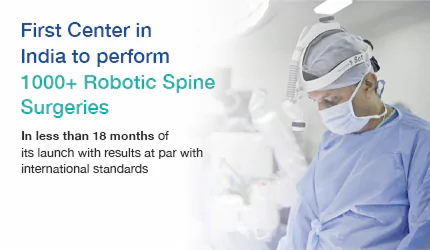When Mid-Back Pain Becomes More Than Just Discomfort
You've probably heard of "slipped discs" in the lower back or neck, but what happens when the problem is in your mid-back? Thoracic disc herniation affects the middle section of your spine where your ribs attach, and it can cause symptoms that might surprise you – chest pain that feels like heart problems, rib pain that makes breathing uncomfortable, or even leg weakness that seems unrelated to your back.
If you've been experiencing persistent mid-back pain, unusual chest sensations, or unexplained leg symptoms, and imaging has revealed a thoracic disc herniation, you're probably wondering what this means and what your treatment options are.
Understanding Your Thoracic Spine
Your spine has three main sections: the neck (cervical), mid-back (thoracic), and lower back (lumbar). The thoracic spine is unique because it's where your ribs connect, creating a cage that protects your heart and lungs. This also makes it more stable than other parts of your spine, which is why disc problems here are less common but often more complex to treat.
Between each vertebra sits a disc – think of it as a tough, jelly-filled cushion that absorbs shock and allows movement. When a thoracic disc herniates, part of this cushion pushes out and can press against:
-
Spinal nerves, causing pain that travels around your ribs
-
The spinal cord itself, potentially affecting leg function
-
Surrounding tissues, creating local pain and stiffness
What Does Thoracic Disc Herniation Feel Like?
Unlike lower back problems that typically cause leg pain, or neck problems that affect your arms, thoracic disc herniation can cause a unique pattern of symptoms:
Common symptoms include:
-
Deep, aching pain between your shoulder blades
-
Pain that wraps around your chest or ribs (often mistaken for heart or lung problems)
-
Numbness or tingling that follows your ribs around to the front
-
Weakness or coordination problems in your legs
-
In severe cases, bladder or bowel control issues (this requires immediate medical attention)
What makes this confusing is that these symptoms can mimic other serious conditions, which is why proper diagnosis with MRI imaging is crucial.
Advanced Diagnosis at MIRSS
Diagnosing thoracic disc herniation requires specialized imaging and expertise. At MIRSS, our comprehensive evaluation includes:
-
High-resolution MRI scans to visualize disc herniation and spinal cord compression
-
CT scans to assess bone structure and planning for potential surgery
-
Neurological examination to determine which nerves are affected
-
3D imaging reconstruction for precise surgical planning when needed
This thorough evaluation helps determine not just whether you have a herniated disc, but whether it's the cause of your symptoms and if surgical intervention is necessary.
Treatment Options: From Conservative to Surgical
Non-Surgical Approaches
Many thoracic disc herniations can be managed without surgery, especially when caught early:
Conservative Management:
-
Anti-inflammatory medications to reduce swelling around nerves
-
Physical therapy focusing on posture and core strengthening
-
Activity modification to avoid movements that worsen symptoms
-
Epidural steroid injections to reduce inflammation
When conservative treatment works:
-
Symptoms improve within 6-8 weeks
-
No significant nerve damage has occurred
-
Daily function is restored
When Surgery Becomes Necessary
Surgery may be recommended when:
-
Conservative treatment fails after 6-8 weeks of appropriate therapy
-
Progressive neurological symptoms such as increasing leg weakness
-
Spinal cord compression visible on MRI scans
-
Bladder or bowel dysfunction (this is a surgical emergency)
-
Severe pain that prevents normal daily activities
Posterior Thoracic Discectomy and Fusion: The Solution
This procedure addresses both the immediate problem (disc pressing on nerves) and the long-term stability of your spine.
Why Fusion is Often Necessary
Unlike in the lower back where disc removal alone might suffice, thoracic disc surgery often requires fusion because:
-
The thoracic spine relies heavily on disc support for stability
-
Removing disc material can create instability
-
Fusion prevents future problems at the same level
-
The rib cage helps support the fusion process
The Two-Part Process
-
Discectomy: Removal of the herniated disc material that's compressing nerves or the spinal cord
-
Fusion: Placement of bone graft material and hardware to permanently connect two vertebrae, eliminating movement at that level
Advanced Surgical Technology at MIRSS
At MIRSS, we employ cutting-edge robotic technology to enhance surgical precision and patient safety:
Robotic-Assisted Surgery
Our MazorX Stealth Edition (Medtronic) – a 3rd generation spine robot with integrated navigation capabilities – provides:
-
Precise planning based on your individual anatomy
-
Real-time surgical guidance during the procedure
-
Enhanced accuracy in hardware placement
-
Reduced surgical trauma
Intraoperative Imaging
High-resolution cone beam CT during surgery allows:
-
Real-time verification of disc removal
-
Immediate confirmation of hardware placement
-
Reduced need for revision procedures
Specialized Surgical Environment
Our state-of-the-art modular operating theaters feature:
-
Advanced robotic integration
-
Optimal positioning systems for spine surgery
-
Comprehensive monitoring capabilities
The Surgical Process at MIRSS
Before Surgery
Your surgical team will:
-
Create a detailed 3D surgical plan using robotic planning software
-
Review your medical history with our dedicated spine anesthesia team
-
Explain the procedure, expected outcomes, and potential risks
During Surgery
The procedure typically takes 2-4 hours, depending on complexity:
-
Anesthesia: Our specialized spine anesthesia team ensures your safety and comfort throughout the procedure.
-
Positioning: You'll be placed face-down with careful attention to spine alignment.
-
Incision: A midline incision is made over the affected vertebrae (size depends on the complexity of your case).
-
Robotic-Guided Access: Using robotic navigation, the surgeon creates a window through the bone to access the herniated disc.
-
Disc Removal: The problematic disc material is carefully removed under direct visualization and robotic guidance.
-
Fusion Preparation: Bone graft material is placed between adjacent vertebrae.
-
Hardware Placement: Screws and rods are placed with robotic precision to support the fusion.
-
Neuromonitoring: Throughout the procedure, intraoperative neuromonitoring continuously tracks nerve and spinal cord function.
-
Closure: Incision layers are carefully closed and dressed.
Our specialized OR staff trained in spine surgery protocols work as a coordinated team throughout your procedure.
Recovery: What to Expect
In the Hospital
-
Most patients stay 1-2 days after surgery (depends on patient to patient)
-
Pain management with a combination of medications
-
Early mobilization with physical therapy assistance
-
Monitoring for any complications
The Healing Process
First 2 Weeks:
-
Wound healing and initial recovery
-
Limited activities with no lifting over 5 pounds
-
Gentle walking as tolerated
-
Follow-up appointment for wound check
Weeks 2-6:
-
Gradual increase in activity
-
Beginning of formal physical therapy
-
Return to desk work may be possible
-
Continued restrictions on lifting and twisting
Months 2-6:
-
Progressive strengthening exercises
-
Fusion process ongoing (bone healing)
-
Gradual return to more activities
-
Regular X-rays to monitor fusion progress
6+ Months:
-
Solid fusion typically achieved
-
Return to full activities as appropriate
-
Long-term follow-up as needed
Rehabilitation with MIRSS
Our dedicated spine physiotherapy team creates a personalized recovery plan focused on:
-
Proper body mechanics and posture
-
Core strengthening to support your spine
-
Flexibility exercises appropriate for your fusion level
-
Gradual return to work and recreational activities
Warning Signs to Watch For
Contact your doctor immediately if you experience:
-
Increasing back or leg pain
-
New numbness or weakness
-
Signs of infection (fever, wound drainage, increased redness)
-
Bladder or bowel control problems
-
Difficulty breathing or chest pain
Minimally Invasive Options
For appropriately selected patients, minimally invasive approaches may be possible:
-
Smaller incisions (2-3 cm instead of larger open incisions)
-
Less muscle disruption
-
Potentially faster recovery
-
Same surgical goals with reduced tissue trauma
Robotic technology enhances even these minimally invasive procedures by providing precise navigation through smaller corridors.
Success Rates and Realistic Expectations
Thoracic disc surgery has good success rates when performed for appropriate indications:
-
Most patients experience significant pain relief
-
Neurological symptoms often improve, though recovery may take time
-
Fusion rates are high, especially with modern techniques
-
Return to normal activities is typical, though some restrictions may remain
Important considerations:
-
Fusion eliminates movement at one spinal level
-
Some patients may experience adjacent level changes over time
-
Complete recovery can take 6-12 months
-
Not all symptoms may resolve completely
Why Choose MIRSS for Your Spine Care?
Comprehensive Expertise
-
Experienced spine surgeons specializing in complex thoracic procedures
-
Multidisciplinary team including dedicated anesthesia and physiotherapy specialists
-
Specialized OR staff trained specifically in spine surgery protocols
Advanced Technology
-
3rd generation robotic surgery with integrated navigation
-
Intraoperative high-resolution imaging for real-time surgical guidance
-
Comprehensive neuromonitoring for enhanced safety
-
State-of-the-art modular operating theaters designed for spine procedures
Patient-Centered Care
-
Thorough evaluation to ensure surgery is appropriate
-
Personalized surgical planning based on your specific anatomy
-
Comprehensive rehabilitation programs
-
Long-term follow-up and support
Questions to Ask Your Doctor
Before making treatment decisions, consider asking:
-
Are you confident this disc herniation is causing my symptoms?
-
What are my non-surgical options, and how long should I try them?
-
Why is fusion necessary in my case?
-
What activities will I be able to do after fusion?
-
What are the specific risks for my situation?
Moving Forward
Thoracic disc herniation can significantly impact your quality of life, but modern surgical techniques offer excellent outcomes for appropriately selected patients. The key is proper evaluation, careful patient selection, and expert surgical execution.
Understanding your condition and treatment options empowers you to make the best decision for your situation. Whether you ultimately choose surgical or non-surgical treatment, having a clear understanding of your options is the first step toward getting back to the activities you enjoy.
At MIRSS (Manipal Institute of Robotic Spine Surgery), Bangalore, we combine the latest in robotic surgical technology with specialized expertise and comprehensive care teams. Our integrated approach – from thorough diagnostic evaluation to personalized rehabilitation – is designed to provide you with the best possible outcome and optimal recovery. From your initial consultation through complete recovery, our dedicated teams in Bangalore work together to support you on your journey back to health and active living.






